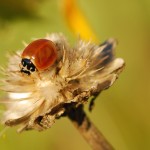Watch this Greta Thunberg-George Monbiot video short and then join the student-led Princeton Climate Strike at 12:30 pm on September 20th in Hinds Plaza. Open to all, part of the Global Climate Strike.
Environment
Finding the lost ladybugs
 So many children love the idea of “bug hunting”—finding an interesting insect to catch, hold, observe and maybe even name and take photos of before releasing it back into its own habitat. As one of the less “scary” types of insects, ladybugs are often a child favorite! If this is an activity that you as a teacher or parent or child enjoys, you can actually make a difference in ladybug research and conservation by working with the Lost Ladybug Project. You can do this while you are already outdoors gardening or simply enjoying some fun as this spring begins and the weather warms up. In learning more about ladybugs as well as how to protect their population numbers and food sources, we humans can also find less chemical ways to protect our own crops. Ladybugs are already helping us do this, so it’s important to understand how they do it and learn how we can return the favor!
So many children love the idea of “bug hunting”—finding an interesting insect to catch, hold, observe and maybe even name and take photos of before releasing it back into its own habitat. As one of the less “scary” types of insects, ladybugs are often a child favorite! If this is an activity that you as a teacher or parent or child enjoys, you can actually make a difference in ladybug research and conservation by working with the Lost Ladybug Project. You can do this while you are already outdoors gardening or simply enjoying some fun as this spring begins and the weather warms up. In learning more about ladybugs as well as how to protect their population numbers and food sources, we humans can also find less chemical ways to protect our own crops. Ladybugs are already helping us do this, so it’s important to understand how they do it and learn how we can return the favor!
The Lost Ladybug Project was started in 2008 to coordinate efforts to survey ladybug populations, first in New York State, and then, across the country. The website, www.lostladybug.org, has step by step directions about how to look for, observe, document, and submit data and photos for ladybugs. The site contains links to two 4-H Science Toolkits designed to help teachers and others guide children in grades K-2 and 3-6 respectively in learning about, observing, and collecting data on ladybugs in their local area. The website and the toolkits both contain loads of fascinating information about ladybugs, including the interactions between native ladybugs and introduced Asian or European ladybugs. The website also includes a number of free-standing curricular units, besides those in the two toolkits.
Ladybugs, both native and introduced, eat the same basic range of things. Ladybugs eat aphids, of course, and lots of soft-bodied insects smaller than themselves. Since many, if not all, ladybugs eat pollen as well, they can be found on flowers and corn plants, eating pollen. On a corn plant, a ladybug will eat a corn borer egg or newly hatched tiny corn borer, if the ladybug runs across it, but the ladybug wouldn’t be digging in after corn borer larvae which have already bored into an ear of corn, so ladybugs aren’t a predator humans can count on to keep this pest from eating fields of sweet corn.
Regardless of a potential shortcoming in the area of controlling larger, entrenched corn borer larvae, ladybugs are considered a good agricultural control for certain crop pests, especially aphids. Because of this, ladybugs are monitored in agricultural settings. When asked about whether ladybugs are disappearing overall, Dr. Rebecca Rice Smyth, entomologist and outreach and data coordinator of the Lost Ladybug Project, indicated that these agricultural surveys of ladybugs do not seem to indicate an overall decline across all ladybug populations.
As to ladybugs in non-agricultural settings, the Lost Ladybug Project hears primarily—or perhaps only—from those who have seen ladybugs. Dr. Smyth believes it would be hard to determine whether there has been any overall population decline in non-agricultural settings, at least, based on those reported—and necessarily—positive observations. Moreover, ladybug populations, like those of any other creature (except perhaps humans), vary somewhat based on yearly weather and other variable yearly conditions, so that it would be hard to say whether any observed decline in one year meant an overall decline.
Whether or not total ladybug populations are down overall, introduced Asian ladybugs have been more successful than natives in many areas, chiefly because the Asians eat more of the available ladybug foods, and eat them faster—and then grow faster and better than their native counterparts. According to Dr. Smyth, a species like the Asian ladybug experiences fast population growth when it is first introduced to an area, then, over time, that growth and population itself subsides. She indicated that since 2008, the percentage of the Asian ladybugs and another currently dominant species, the seven spotted ladybugs, introduced from Europe, do not appear to have changed that much. But several of the most ubiquitous native ladybug species have all but disappeared from many areas, outcompeted by the introduced ladybugs.
Humans, perhaps excluding kids, appreciate ladybugs primarily for their eating of various critters that eat our crops. Why should humans care about some species disappearing, if Asian ladybugs are eating the aphids and the other soft-bodied insects that we want to see gone? Each species of ladybugs has its own “specialties” in terms of the habitat and microclimates which it prefers—and where it is most well-adapted. Some like high trees, some prefer lower areas. Even what the aphids are eating goes into ladybug location preferences—after all, the juice of each plant being sucked by aphids has a different chemical composition and each species tolerates a certain range of chemicals more easily. So when the introduced species drive out other species, the specialties, in terms of preferential feeding plants or part of the habitat preferred, provided by the lost species disappear, and may not easily be regained.
More importantly, as one species becomes so dominant at the expense of others, the stability of the entire system is weakened.
By now, you may be wondering how you can help the Lost Ladybug Project. Whether you are an educator, student, beginner or experienced gardener, or simply anyone who is a lover of nature, insects and conservation, you too can participate! Experts from the project cannot be everywhere at once, so they would love for you to help. The process is simple—when you are out in your backyard or home or school garden, keep an eye out for ladybugs and snap a few pictures. Any pictures are helpful with the project’s studies, not just those of rare species. It is also helpful to see a diverse collection of photos from across the country, so your location is not a restriction! Even if you don’t see any ladybugs, feel free to let the project know that you were out searching, too—it is important to know that some areas may be lacking ladybug populations. Once you have your photos, upload them at www.lostladybug.org and provide some key details, like the time, date, location and type of habitat you spotted your ladybugs and took your photos in. When you visit the site, click the “participate” link on the toolbar at the top of the page. Here, you will find more details and a submission form to complete when sending in your photos.
Are you still curious? Visit the Lost Ladybug Project’s website for more on their latest news, research, upcoming projects and more ways for educators and students to participate together!
– Priscilla Hayes, Garden Educator, Community Park Elementary School and JW Middle School
